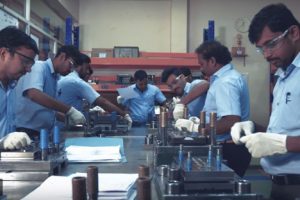[ADV] All You Should Know About Progressive Die Stamping
Progressive die stamping is a type of manufacturing process that is used to cut and form products using a die. The precision stamping die is progressive in nature which means the raw material is pressed simultaneously and sequentially through a series of stations that work on the material until the desired shape is obtained.
Progressive die stamping is different compared to transfer die stamping, which transports material from one station to another to work on the part. It is typically used in larger part production using multiple presses such as automobile fabrication. Progressive die stamping on the other hand is preferred for larger volume production of smaller parts.
Working Detail.
The progressive die stamping set-up can be detailed as follows, the die is fitted in to the stamping press, when the press moves up the die is in open position and when the press moves down the die is in closed position, the raw material in the form of a sheet, typically a metal is fed using a coil strip that continuously feeds the press. Each time the press moves down the die presses the strip to perform a specific type of action, as the strip moves through the press it is incrementally stamped up to the part where the part design is achieved. Some of the actions that can be performed by the die are cutting, coining, bending, shaving, extruding, lancing, and drawing and embossing. As it is a continuous and accurate process, the feed as well as the die and the press need to be carefully fabricated so that speed and part detail is not missed. To maintain smooth and accurate progression along the press, bullet shaped else conical pilots enter previously worked on areas to ensure alignment is proper, this primarily due to the fact that the coil cannot control the flow as the sheet moves along the press especially for longer dies.
Materials Used.
The die itself is typically made using tool steel to withstand load and to work continuously for long hours. The raw materials are mainly metals, common examples include but not limited to steel, brass, copper, aluminum, stainless steel etc. Even plastic is used based on the type of product that is fabricated.
Benefits.
Apart from the obvious cost saving associated using precision stamping dies, here are some of the other benefits achieved
Setup Time – As it is a single set-up it is relatively easy and simple to get this installed and up and running.
Production Speed – Due to the continuous nature of manufacturing, production speeds can be made to vary for faster production if necessary.
Less Scrap – It is very well designed so that once the part has been fabricated there is very less wastage on the source strip, even the remaining raw material can be further recycled and put to proper use.
Volume – It is possible to produce accurate parts of small size with large volumes using progressive precision stamping dies.
Different Geometries – The structure facilitates creating parts with different geometries.
Applications.
Due to the above advantages, progressive die stamping finds application in the following industries for part production.
- Automotive
- Aerospace
- Electronics
- Locomotive
- Agriculture
- Heavy trucks
- Medical
- Recreational Vehicles
The above industries also use transfer die stamping based on manufacturing needs.
Eigen has a vast expertise in harnessing the above advantages of progressive precision die stamping, our equipment coupled with the skilled labor and up-to-date knowledge helps us to serve a wide range of industries at a global level.
from Young Upstarts http://bit.ly/2VnN88D


Comments
Post a Comment